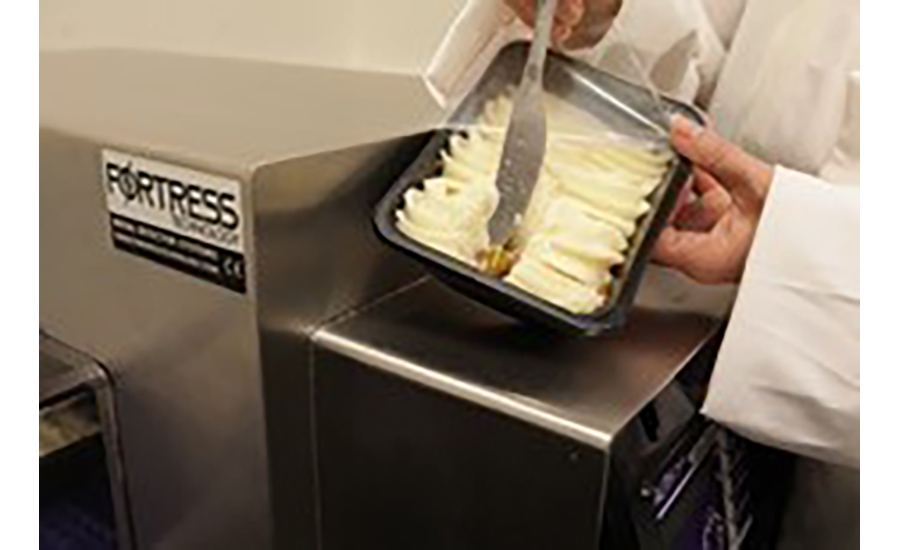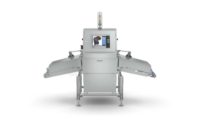The reported rise of recalls can probably be attributed most to the food safety drive by supermarkets and club stores as well as higher food safety compliance right down the food chain. Although foreign material control is inherently process driven, if people aren’t trained to understand what could go wrong and what to look for, product integrity can still be compromised.
Meat and poultry processors must always consider the whole contaminant picture – Good Manufacturing Practice, machine maintenance, design of the production facility, as well as workforce knowledge.
Metal detection is the most common technology utilized on meat and poultry processing and packing lines, mainly due to the fact that metal is the number one contaminant. However, X-ray can be used as a complementary technology providing the opportunity to detect some non-metal contaminants. Additionally, X-ray can also provide other product analysis features, for example fat content.
Soaring farmgate costs
Farmgate input costs have reached unprecedented levels. The projected price increase for animal feed and medicine, fuel and power, and fertilizers is estimated to rise by 36%, 43%, and 134%, respectively. For meat and poultry processors, it can be hard to justify the loss of valuable, expensive product if contaminants could have been caught and actioned upstream.
Additionally, the current cost of living crisis has resulted in consumers now viewing meat as a luxury. As a result, meat and poultry producers are feeling even higher pressure to deliver contaminant-free products and prevent irreparable brand-damaging recalls.
Saving money vs. saving face
An inspection system can be integrated almost anywhere along a meat and poultry processing line. Most commonly, processors will choose end-of-line checkweighing and contaminant inspection technology after meat products have been prepared and packaged. Functioning as a final safeguard, at this phase there is virtually zero possibility of a new contaminant being introduced. However, if products are rejected, the costs incurred as a result of wasted food, labor, and packaging can be exponentially higher.
Although metal detection offers superior sensitivity to foil contaminants, product effect common in meat products can potentially limit performance. Equally, X-ray systems can be technically challenged on high-speed processing lines.
Establishing your biggest contaminant risks and most cost-efficient CCPs and inspection solutions all help to ensure a robust HACCP-compliant food safety strategy. Delivering maximum profitability and avoiding costly waste.
Foreign matter fears
There are multiple sources that can introduce contaminants into meat and poultry processing lines. Foreign matter, especially metal, may be present in incoming raw meats.
The nature of foreign bodies in meat is slightly different from other food types. While imported meat may contain the usual contaminant culprits, metal, glass, plastic, wood, or stone, they also contain bones. If a product is sold as “boneless”, these intrinsic foreign bodies are considered undesirable and potentially dangerous.
Other processes involved with handling the produce, such as cutting, trimming, deboning, mincing, or grinding, can potentially introduce contaminants. Some bones may go undetected to the naked eye and metal-to-metal contact in devices can result in metal shards. If processing equipment is not properly maintained, it also augments the risk of metal parts or flakes simply breaking off onto products.

If contaminants are undetected at the largest size, smaller pieces could end up being dispersed throughout an entire batch of beef patties or poultry nuggets. Harder and larger contaminants could also damage processing equipment, resulting in downtime, expensive repairs, or even machinery replacements.
The final contaminant risk is biological pathogens. Bacteria multiplies every 20-30 minutes depending on the conditions, and prefers high-protein foods, especially in liquid form. With compliance demanding the highest levels of sanitation, it’s important for meat and poultry processors to integrate hygienic, easy-to-clean inspection systems that prevent cross-contamination.
Prevent before you pack
Supplier weight checks can help to safeguard against under or overweight products. For high-value produce, checkweighing verification becomes even more imperative. Bulk checkweighers can be utilized to efficiently monitor incoming stock and return rates, ensuring processors are receiving the exact weight, volume or quantity ordered. The most robust case weighers can accurately verify the weight of incoming ingredients in formats up to 110 pounds. Additionally, some processors may utilize bulk metal detectors to inspect at this initial primary processing stage, reducing the risk of potential contaminants early on and mitigating damage to down-stream processing equipment.
Prior to packaging, the raw produce may be manipulated and interact with a variety of processing equipment. Inspecting for contaminants at this stage allows for the possibility of rejected produce, once the contaminant is removed, to be reintroduced. During this stage of production, X-ray equipment can be useful to detect non-metallic foreign matter, especially in products labelled as “boneless.”
For meat applications such as sausages, chicken pieces, beef patties, pâtés, meat sauces etc., a pipeline metal detector is the safest, most hygienic option. A meat pump metal detector is designed to assist in inspecting high-viscosity meats for metal contaminants as they are being pumped through a pipe, without compromising detection sensitivity.
To beat the spread of foodborne pathogens accumulating in industrial meat processing environments and avoid cross-contamination, a pipeline metal detection system should be designed with minimal places where meat residue, water ingress and bacteria can build up and potentially get embedded in pipes and crevices. Additionally, they should be able to withstand high-pressurized washdowns after every product changeover.
Due to its highly conductive nature and high iron content, meat generates signals that can mistakenly be interpreted by a metal detector as a contaminant. Additionally, bubbles and voids in the product flow can trigger false rejects, leading to increased waste and needless production downtime. To overcome this product effect, a Meat Pump should address these challenges by applying powerful digital signal processing technology to clearly distinguish the signal generated by a metal contaminant from the product being inspected.
For burgers or products like meatballs, an in-line checkweigher may also be advisable. Connecting to automatic portion control machines, individual pieces that are off-target weight can be removed and reworked. Programmed software can also provide corrective feedback.
End-of-line safeguards
For a GFSI-certified business with a continuous-improvement mindset, adhering to best food safety practices and ensuring products are safe for consumption is of utmost importance. Inspecting products after packaging using an end-of-line metal detection and/or X-ray system is the most important CCP. For most retailers, it is also a supplier requirement.
The most common high-risk contamination culprit in food processing remains metal. However, X-ray machines may be advisable if there are specific risks, for example potential contaminants like bone that won’t be detected using a metal detector. Both X-ray and metal detection systems offer distinct advantages. A manufacturer always needs to factor in their biggest contaminant risks. It’s equally critical to understand that each type of meat – minced, large joints, cooked, frozen, etc. – have varying product effects and can therefore behave differently in a metal detector.
To comply with global weights and measures FSU directly to QA and technical personnel is increasingly imperative on fast-moving meat and poultry processing lines.
For traceability and audit purposes, records must be retained in order to verify that each system is performing to defined FDA and GFSI food safety standards and to prove that inspection procedures are being followed consistently and correctly. Switching to digital record-keeping is generally favored as they are more secure, less prone to human errors and tests cannot be performed retrospectively. Additionally, it gives meat processors immediate access to documentation in the event of an unannounced supplier or third-party inspection.
Automatic testing is also advisable. These are available for use on pipeline and conveyor metal detectors to eliminate human errors, reduce labor demands, and save time and money. One of the key benefits of automatic testing is food safety and QC standards are maintained, in many cases improved upon, without compromising production. The results from tests are automatically logged and digitally stored for GFSI audits.
Stay strategic
HACCP guidance states that critical control points (CCPs) should be located at any step where hazards can be prevented, eliminated, or reduced to acceptable levels. Every food processor’s needs are different. The same applies to products.
Rather than looking for patterns, examine potential CCP-holes. This is even more critical if a production process or packaging is changing. An annual HACCP assessment – a requirement for most meat and poultry facilities - will help to ensure all essential inspection points are covered and, most importantly, retail and foodservice compliant.
Eric Garr is regional sales manager at Fortress Technology.



